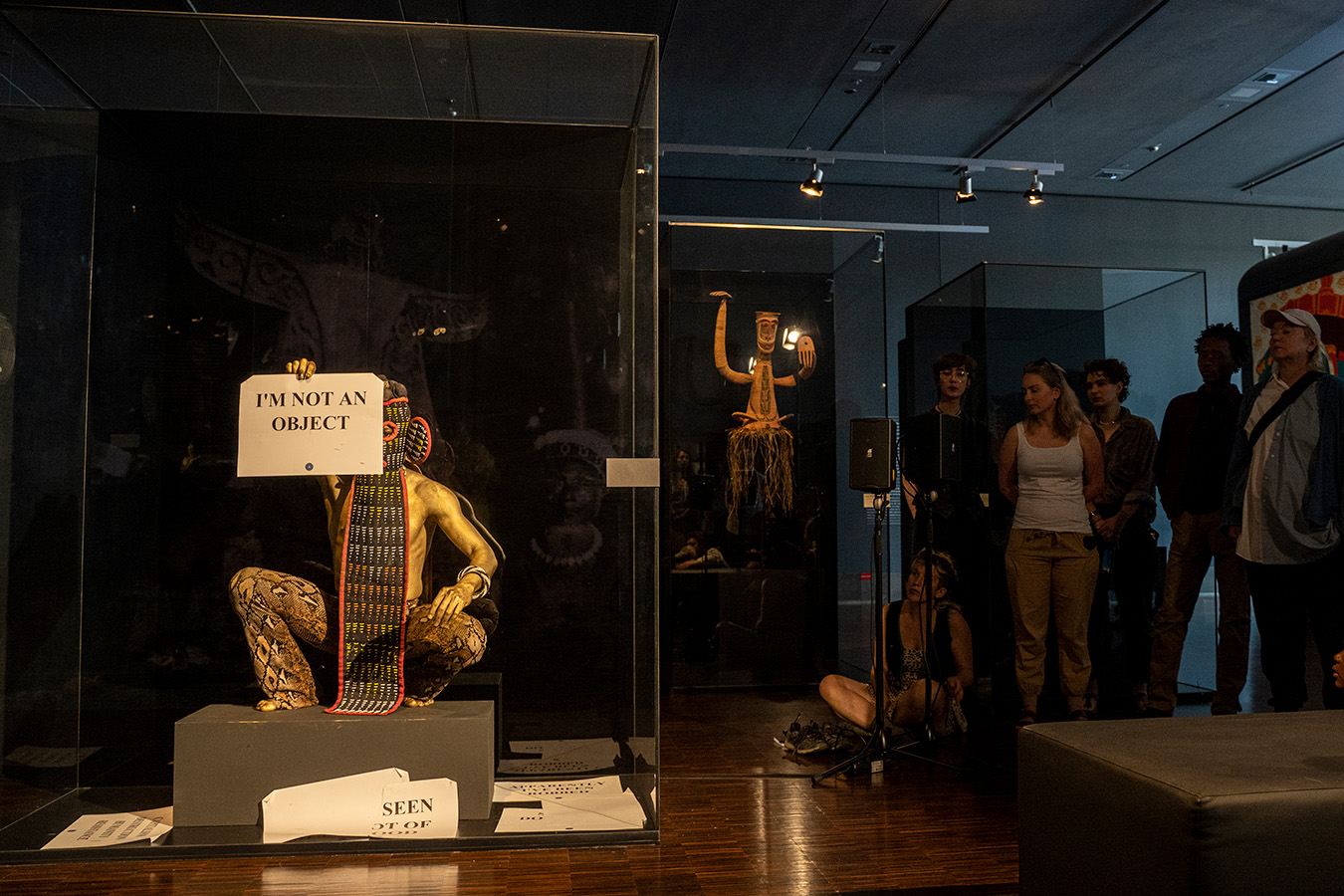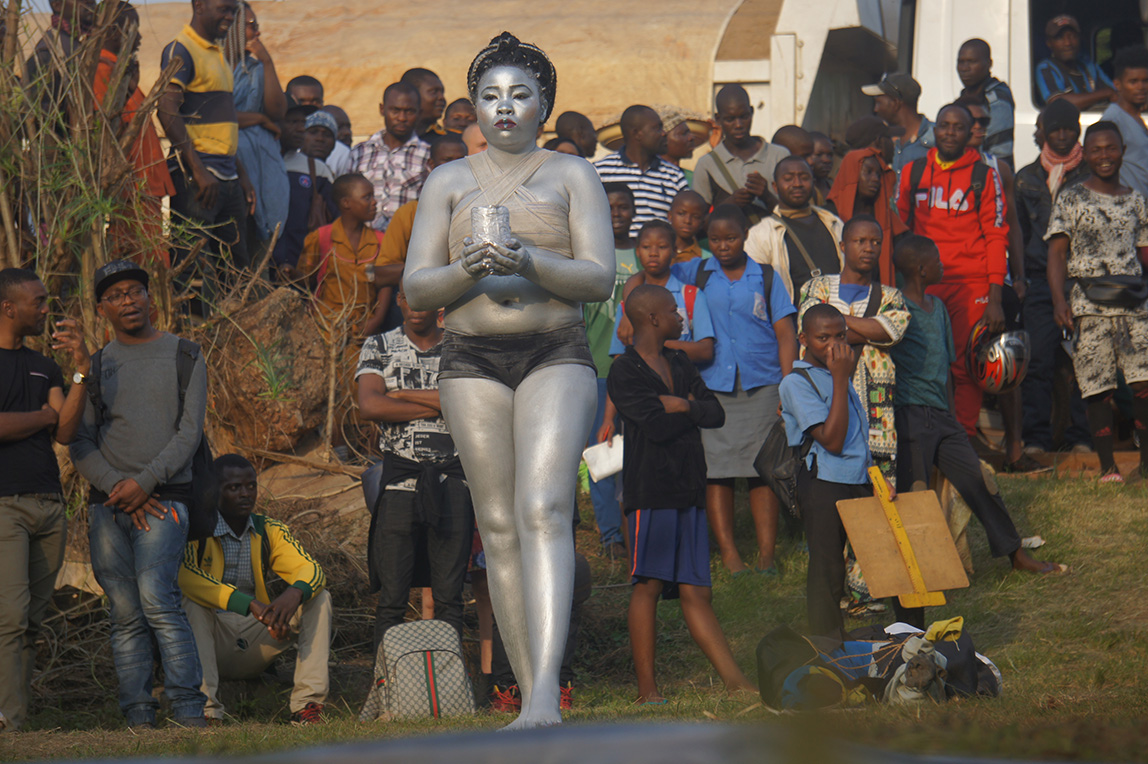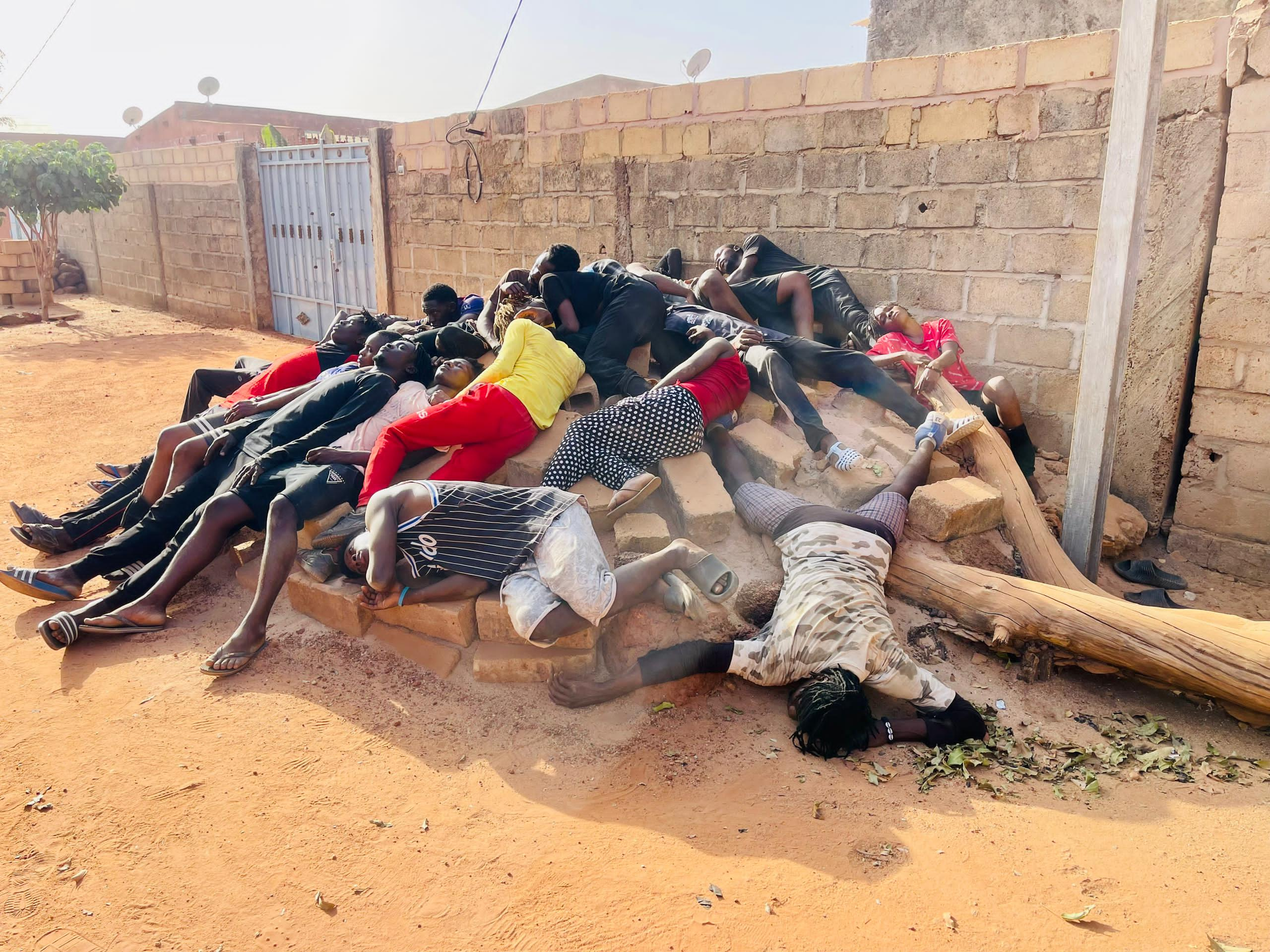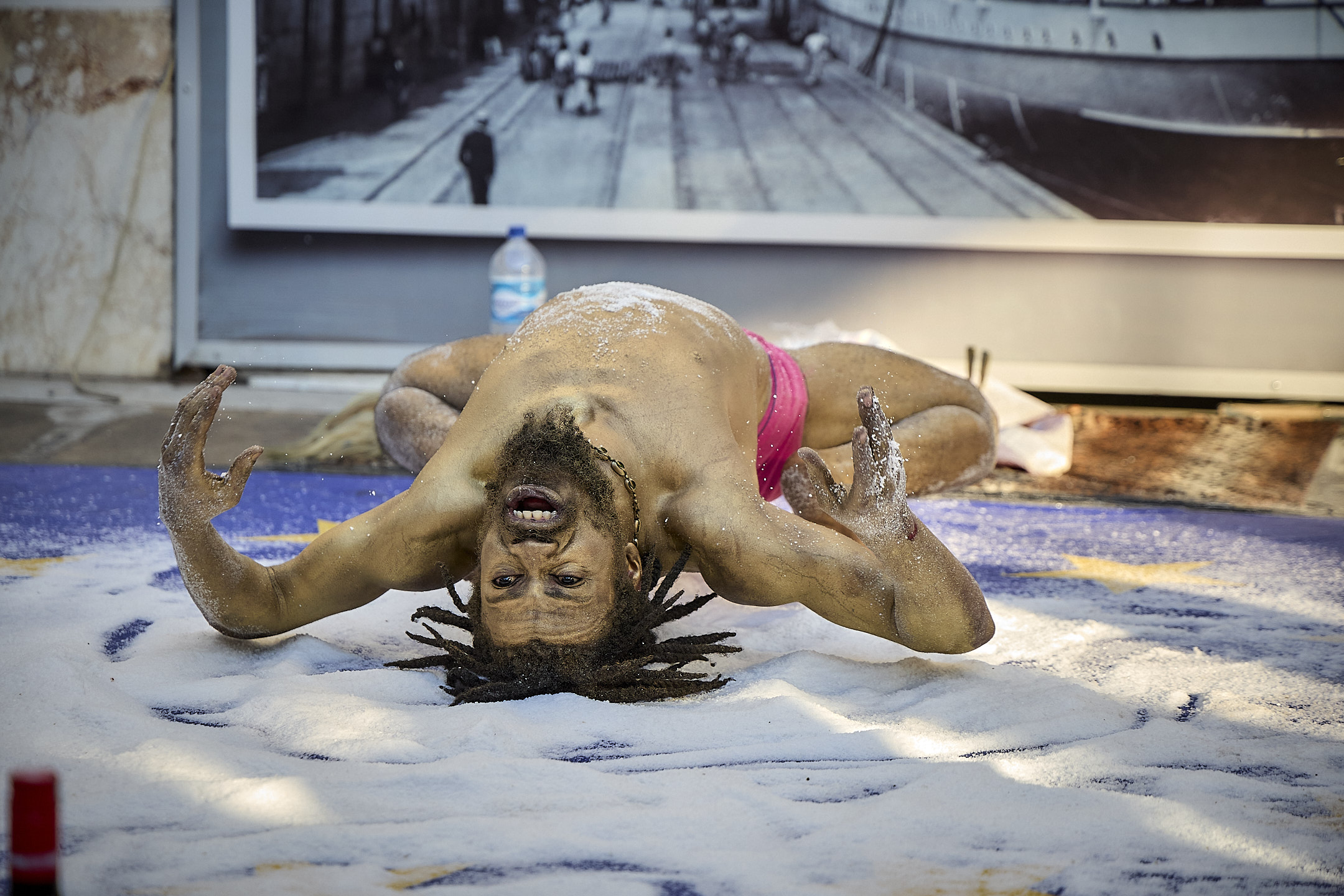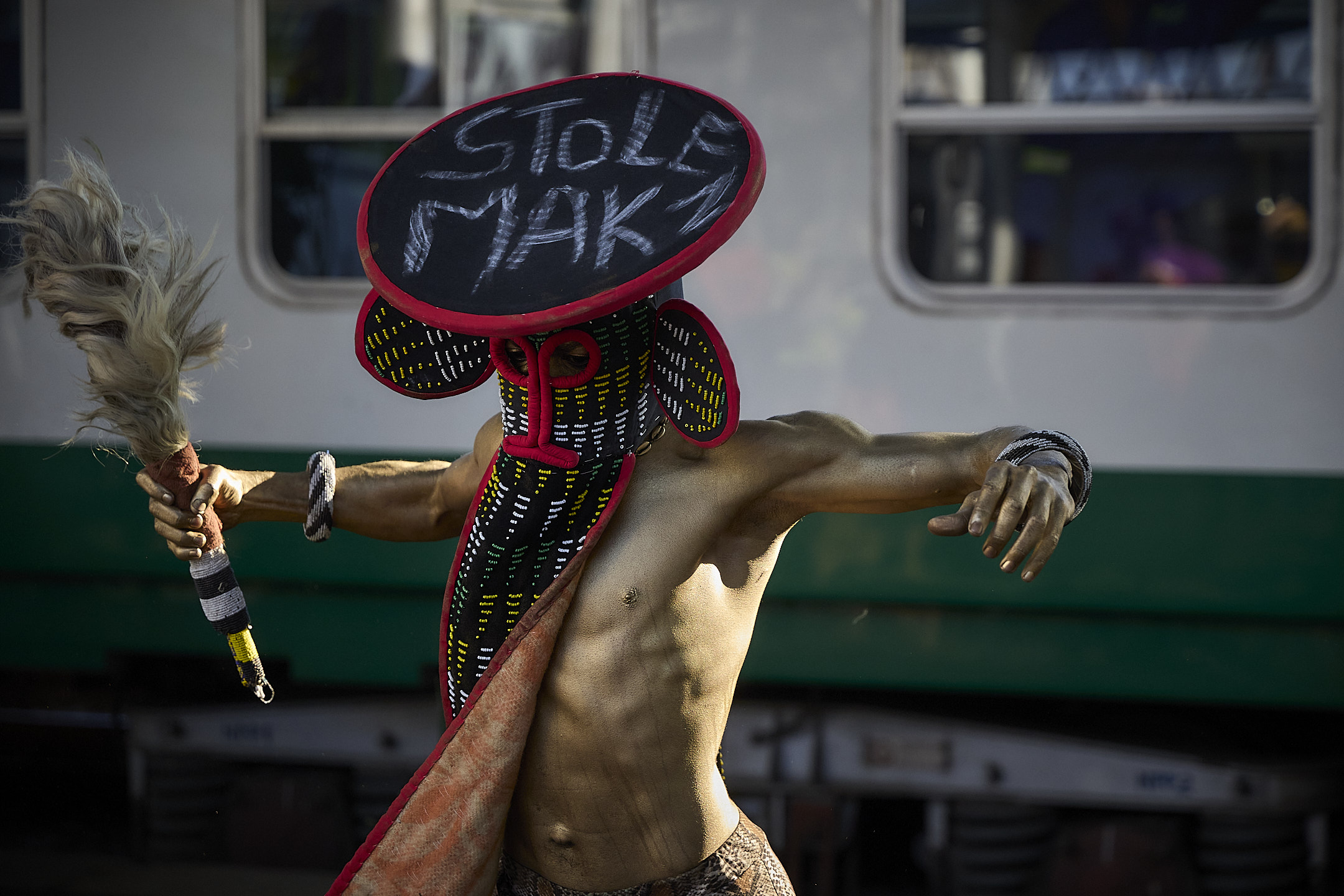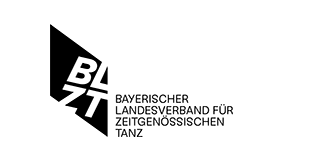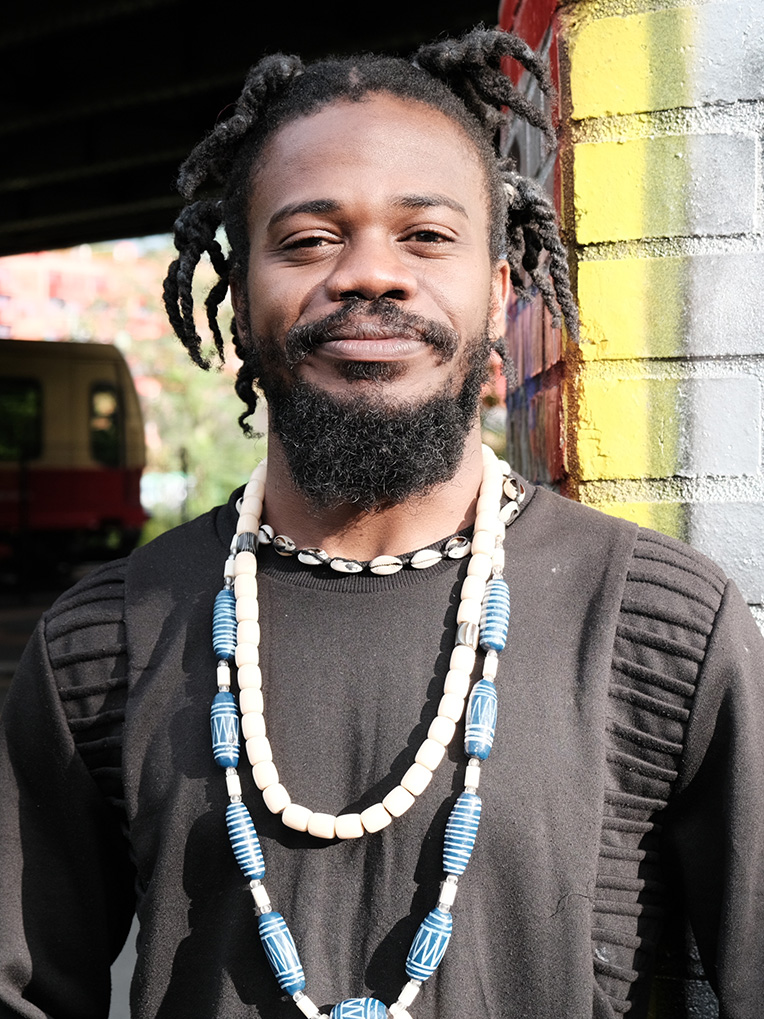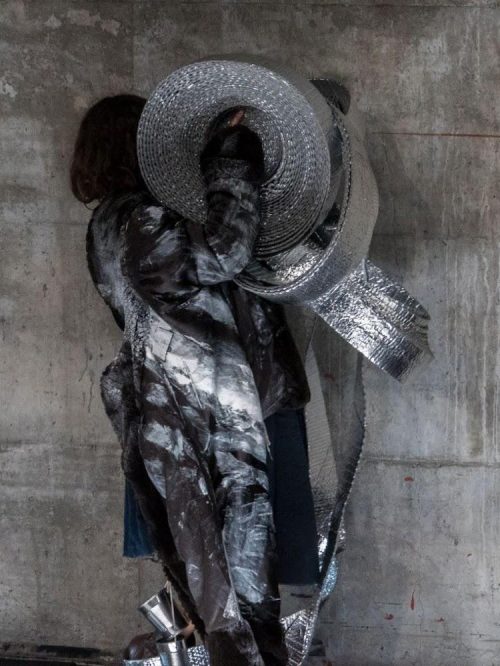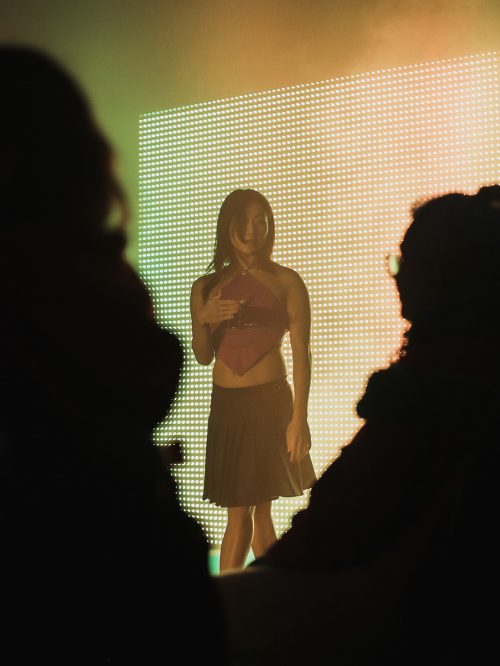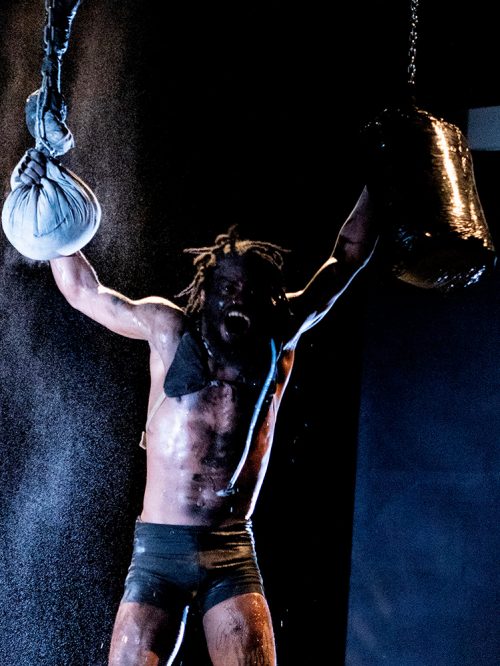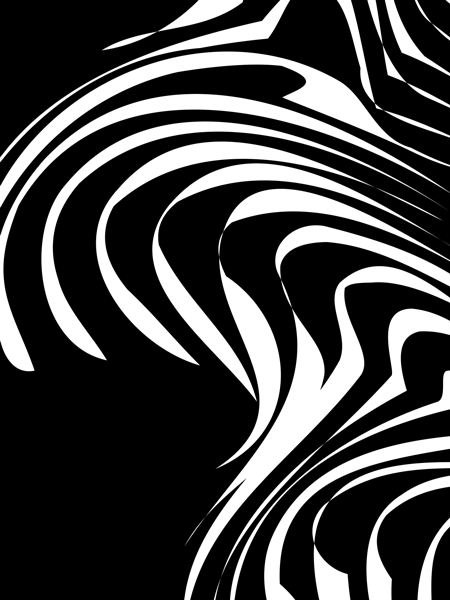Works that heal colonial bite wounds
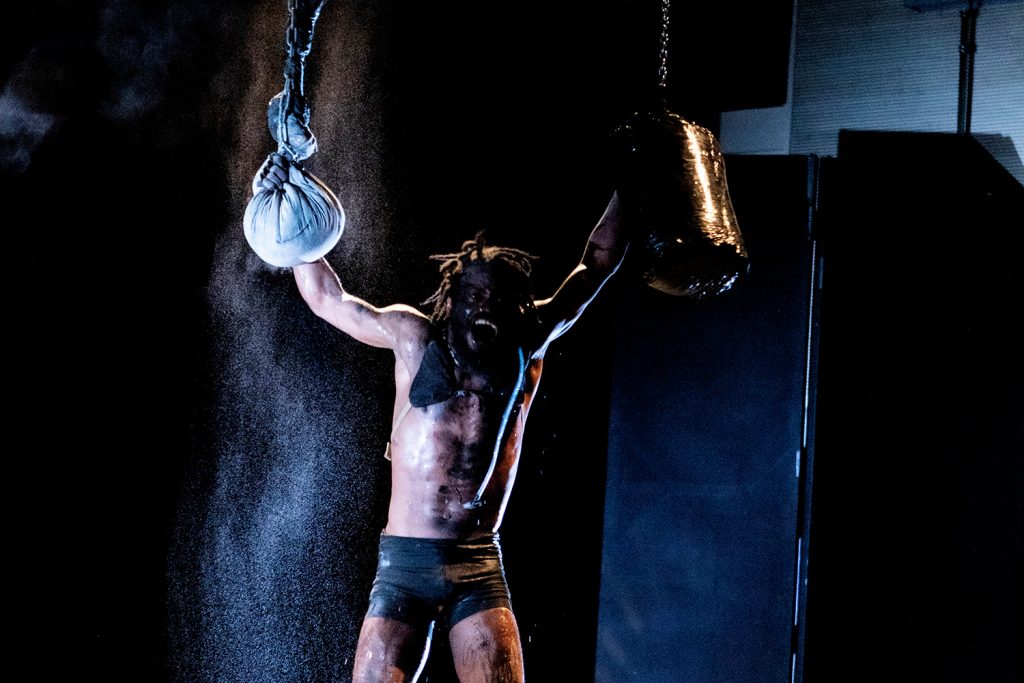
[Note by the editors: This article was written in direct response to the impulses from the invitation to contribute by CHAKKARs – Moving Interventions]
1) How do you work artistically in your local context in Cameroon? Modaperf can be a good example
Before I respond , I would like to mention where I come from, as it is the basis of all my creations today.
I was born in a village in western Cameroon, originally from the Bamilékés people, one of the largest communities in the struggle for Cameroonian independence. It’s a legacy to be born into this community.
I grew up in the streets of Douala (the economic capital), where I started dancing in the streets as a result of the lively environment of noise (nuisances) 24 hours a day non-stop. It was in this context that my art took shape. My background is in so-called “urban” dance, actually hip-hop. From break-dance to popping, passing through robot, waving, animation, smurf… I was called SNAKE by the Cameroonian public who saw me dancing like a snake. Today, I keep this name as a reminder of the testimonies of those around me and of the hip-hop community in Cameroon. (See BIO online).
The Cameroonian context remains very particular in terms of its way of life, its way of functioning and its system of survival in the face of vast policies of oppression of freedoms.
My work in this context is a union between the needs and urgencies of civil society, communities, today’s [scientific] knowledge, rites (ancestral heritages) and my artistic works. “I can’t create if my art doesn’t connect with communities”. It’s the context that inspires us to create works that emancipate us from the great night, as Achille Mbembé used to say.
Society is the benchmark for diagnosing all social forms of behavior. It’s a center of action open to all. A space that contributes to consulting urban poetry as a source of inspiration for today’s theaters. Here, “theater” is presented as a language invented by the actors of society. The artist in this urban constellation is society’s own physician.
The city is our daily inspiration. The foundation of the struggles and resolutions of a territory, of a people. It is in the midst of precarious conditions, doubts, uncertainties, fears, wars, conflicts, divisions and shared social concerns that we practice creating, inventing, hoping and working to build our imaginations in the service of shared artistic and cultural development. With the focus on putting art back at the heart of social debates, our “hors les murs” artistic approach [approach outside the walls] also enables us to reinvent an artistic and social dialogue with our local populations, in cities and neighborhoods that are sometimes far removed from our cultural activities.
I wear two hats: I am the choreographer of the Compagnie Zora Snake and the founder and artistic director of the Modaperf international biennial in Cameroon.
As a choreographer, performance artist and dancer, who interprets his own works, my work is based on extensive research in discussions with researchers, historians, scholars and village elders (guardians of the traditions and customs associated with our identity). All my works have a creative process. That is why they need a lot of time before they can be presented to the public, because as I like to say: “I don’t make a show, I represent life, the conditions in which we exist.”
My performances are inspired by African utopias, which are actually existing beliefs, not myths. My performances exist through the present spirit that inhabits the work, and in the end remain in the imagination, in other words, in the disturbance of public comfort.
There are several phases in the creation of a work. It’s a ritual. They take time to conceive the work.
First, I infiltrate my imagination, let the spirit travel and finally die in the flesh, only to be reborn on stage.
The work is spirit, spirit is infinite.
In a context like Cameroon, sometimes I have to die to divert politics from its barbaric force and power, which for me are a legacy of colonization. The act of dying allows me to breathe to create my work. The subjects I tackle are part of my daily life (borders, religion, immigration, neo-colonialism, stereotypes, divisions, violence, discrimination, racism…). This is why my artistic commitment in the context of Cameroon is first and foremost political. Poetry is a pretext for confronting the situation.
“The world is a mongoose, you have to bite to survive”. An inspiration from the titanic battle between the snake and the mongoose.
View the works online
Sometimes without expecting subsidies to betray the art, which is not a production for excessive consumption in the contemporary creative industry, as it is thought, but the art as the spirit and inner conviction of the artist. As a creative choreographer, lthe trigger of the creative act lies in the mind, that is, in the dreams and predictions of the world. I draw on all kinds of elements to create a work. It is a cross-generational connection.
We believe in the omnipotence of the ancestors who had a good grasp of the current world situation before the arrival of the slave trade, slavery, colonial rule and colonization.
For this reason, I create from the village of Sonkeng, near the sacred places and huts of my grandparents, to decode my existence subjected to the world matrix.
I recognize myself as close to the ancestors to invent, give birth, deconstruct, heal and care for the world.
Here, the situation in Cameroon is similar to other countries in Africa (lack of infrastructure for contemporary art, lack of subsidies, lack of support, lack of theater and dance venues …). The artist must become more and more involved in order to turn his shortcomings into inner strength.
This is why I am implementing the Modaperf festival, training courses, creative projects and several ongoing activities in Cameroon. The most important of these is the creation of an artistic center for dance and performance in the village of Sonkeng. The center is dedicated to all national and international artists…
INTERNATIONALE BIENNALE MODAPERF: a fundamental example of my work in the context of Cameroon.
The Modaperf Festival was launched in 2017 and has since become the Modaperf International Biennale. It serves as a platform that promotes connections between art, society and education, while also facilitating international dialog.
A true “hub” of reflection and exchange, it addresses the key challenges of our time. The Festival MODAPERF (Mouvements, Danses et Performances – abbreviations for: Movements, Dances and Performances) was founded by the Cameroonian choreographer and performance artist Zora Snake in Yaoundé. It has established itself as an international and professional platform. It offers space for artistic encounters, training, dialog, knowledge exchange and the discovery of young local talent.
At the same time, it promotes the cultural development of cities such as Douala, Yaoundé and Dschang by making art accessible to “everyone”. MODAPERF is considered a place for socially engaged art that creates connections and strengthens the dialog with urban societies and civil societies in Cameroon. With its concept of a traveling festival, the biennial connects urban and rural spaces, creates encounters with a broad audience and builds lasting relationships.
One of Modaperf’s ways of working is to involve civil society in program planning, i.e. we consult the youth in the cities and villages to understand differences of opinion on issues that unite us. In this dialogue between the organization and the population, we analyze a theme that appeals to both local and international artists and the local population in order to transform the moments into special editions. Our programs take place in spaces of memories and relics to find the traces of our ancestors and heal the wound of history.
Modaperf is a space of revolution, but also a space of healing.
Its programming is conceived with a dramaturgy of urban space and artists’ content, like an overall artistic creation. As it is free and open to the public, it is important to mention the financial difficulties we face every year at the Biennale.
Our new working framework is designed for two years, i.e. the year of the “Modaperf Labs” (nationwide call for applications, pre-selection of artist groups on presentation of the work-in-progress, establishing contacts with researchers, scientists, university professors, anthropologists, sociologists, art historians and professionals from the artistic field, etc.) for an in-depth dialog with artists about their creative process. The following year, they are accompanied in creative residencies to present their works to the public during the Modaperf International Biennale in November.
The Modaperf 2025 International Biennale will take place from November 26 to 30, 2025 in the city of Dschang, the village of Sonkeng and Yaoundé.
(See Modaperf 2025 dossier with request for support)

2) How does your work deal with the ideas of colonialism/decolonization?
CREATION PROCESS
The working process of Zora Snake is generally anchored in the traditions of the Bamilékés, where the traces of the Bamilékés go back from the Baladis to ancient Egypt. The process is inspired by what is known as “Bantu thinking”, where the transmission of knowledge and wisdom is initially circular, oral, organic, physical, spiritual, artistic, scientific and takes on the morphology of a shedding snake, reincarnation and transformation. This process contributes to penetrating into the interior of the human being, into the depths of his being, his openness, his sensitivity, in order to love him and give birth to a living work. The journey is a process to open the dialog between the outer and the inner world, the vine that one perceives and the vine that one creates (in between) to transform oneself. This process also contributes to the transformation of the tools to promote a state of the body that serves the construction of the work, dance or poetry in connection with the sacredness of life. Our science is organic, animated by bodies and spirits that can express a certain historical connection of absurd but real facts. It is a cosmogony.
His projects create a link to his past and future creations. It is a suture with the thread as the signature of his dramaturgy, like the snake that sheds its skin again. To find the originality s of his works in it, he defines the process as a cosmic snake that crosses the universe, whose anchorage is in the village, to then find the uniqueness in his artistic language. His works are designed to “stain the visible”, to confront the world with its contradictions, absurdities, follies and crises. An art that questions the existence of the living, the temporality, spatiality and movements of today’s world. A way of escaping the prevailing narratives.
For the visible (living), materialization through the body is a means of transmitting the space for universal/invisible/inexpressible thoughts that reflect on the reality of our world. In the land of the Bamiléké, the world is shaped by humans and not the other way around. “What builds the species is what makes the world.” (In the Bamiléké cosmogony, there was a creation of the world before the creation of the world).
Zora Snake considers the art of dance and performance as a sacred space, a place of questioning our fantasies, a place that moves us in the perception of our external world in duality with our internal world, a space of overcoming, a refuge of our multiple reflections that crisscross the world, a space of transmission and disclosure of the challenges of the community that today is called “public”. In this process of reflection, the choreographer interweaves his performances to better understand the space-time framework in which we inscribe our creative works as archives of a collective future.
For Zora Snake, the body is an immaterial and multifaceted material. It is the space for accumulations of all intuitions, dreams, utopias, follies, crises, phantasms, realities and dreams that transform within us to perform an artistic gesture haunted by madness, real and fictional utopia, poetry and politics. How do we experience the work within us and after its conception, beyond the beautiful, the aesthetic?
“Our body, tool of labor that shapes the becoming of our humanity.”
In this work process, Zora Snake reveals the “unspoken”, “the whites” of history that escape and return as ghosts of cultural shock.
Already with my artist name “SNAKE” the conflict of ideologies begins to take effect, about the contradiction between the creation of the world and the hypocrisy of Christianity according to religious beliefs that see the snake as an evil animal.
WHO OR WHAT HAS DECLARED THIS ANIMAL, WHICH GOD CREATED, AS THEY SAY, TO BE EVIL, AFTER IT HAS GIVEN US WISDOM, INTELLIGENCE, KNOWLEDGE AND INSIGHT AND OPENED OUR EYES?
My work began to feel the aftermath of colonization when I returned to my native village to deepen my research.
Each work is an attempt to evade and escape the colonial machine. By deconstructing the inherited ideologies, my work finds its way into the imitations of the discourse on colonialism. “We are not yet out of the colonial yoke. It has only changed its form, and that is the most dangerous thing for our Africa, our humanity.
Beware, even Europe is colonized by its own luxury and is a slave to a wealth that does not belong to it.
My work invites Europe to decolonize itself first before trying to decolonize Africa.
See “ Les séquelles de la colonisation ”, “ les masques tombent ”, “ l’opéra du villageois ”
My next creation 2025, with 7 artists on stage is “ COMBAT DES LIANES ” in production at the Théâtre National de Bruxelles with supporting co-producers. The project will premiere on September 23, 2025 at the Studio of the Théâtre National de Bruxelles.
Bio
Zora Snake is a Cameroon-born dancer, choreographer and performance art researcher, Zora Snake is the founder of the Compagnie Zora Snake and of the international festival Modaperf. He reinvents artistic creation in the public space, imagining new collective spaces for encounters, exchanges and sharing. His transgressive, explosive and committed creations intersect with the ritual practices of his ethnic group, where dance is a strong value of social structuring. He is the author of several dance and performance creations always passing through professional (international) contemporary scenes. Follow @ZoraSnake & @ModaperfBiennale for more.


